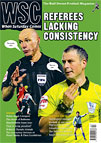 Forget the Euros and Olympics, England’s best chance of glory this summer could come on hallowed Subbuteo turf writes Tom Hocking
Forget the Euros and Olympics, England’s best chance of glory this summer could come on hallowed Subbuteo turf writes Tom Hocking
Among endless aisles of Lego Harry Potter, Ben 10 figures and another new version of Cluedo – this time with added rooms – at the Toy Fair 2012 in London was John Barnes. He turned up to relaunch one of the most iconic toy, and football, brands of the 1970s.
The official Subbuteo disappeared from toy shops 16 years ago. Since then various incarnations have departed as quickly as they arrived, but the Federation International of Sports Table Football (FISTF) has kept the sport alive, running clubs and competitions throughout the world. They organise the annual World Championships, which this year will be held in July, in Athens.
The honorary president of FISTF, Alan Collins, has represented England 36 times at the game’s highest level. He hopes this launch will introduce a whole new generation to the little plastic men and their oversized footballs. “I started playing Subbuteo in 1970,” says Collins. “My father took me to the first World Subbuteo Championships, at Wembley. I started playing regularly in the scout hut at Wembley after that. Seeing the World Championships for the first time gave me the bug for the sport. I realised you could play for your country at Subbuteo as well as at football.
“You don’t have to be good at football to be good at Subbuteo. That is why it is great for the kids. Anyone can play and recreate the end-to-end action they see in the Premier League. Once that happens the people who take the game seriously will move up and maybe England can have a chance of winning their first official World Championship.”
Much like in the real game, England’s table football history is littered with near misses and underachievement. Italy have won ten of the last 13 World Championships, with Belgium, Holland and Spain providing the other winners. England’s closest brush with glory came in Germany 2006, when Collins was beaten 1-0 by Austria in the semi-final. “We have always been there or thereabouts,” he says, “but this is the brand we needed to reignite the sport in this country.”
The tactics they employ differ slightly to the Premier League. The typical Subbuteo formation, according to Collins, is seven in defence and three strikers. “The pace of our sport is underestimated. A lot of world class players can destroy an entire defence with one pass and score within three seconds. It’s a very skilful game when you see it played like that. We like to think it’s a mixture of football and snooker, with the showmanship of darts.”
For the more amateur players among us there are signs that this version of Subbuteo will be worth the wait. The most important innovation are the players themselves. Made from a more flexible plastic, no longer will you have a mixed up team because a few figures have snapped at the ankles – normally because you have unwittingly crushed them with your feet. There will be fully licensed teams for the first time. Chelsea, Liverpool and Manchester United have already signed up, along with England, Ireland and Scotland. These teams, with more promised shortly, will have detailed club-specific kits. There will also be the more general purpose Subbuteo teams we are used to. You won’t even need to iron the pitch before playing.
Can Subbuteo really compete with computer games? Peter Rooke of Paul Lamond Games, the company relaunching Subbuteo, believes nostalgia will play an important part in the opening round of sales: “A whole generation haven’t heard of this product. We want dads to buy it first and start playing it with their sons like they did when they were kids. We’re mindful of the heritage of this brand. We’re in it for the next decade and over those years we will be expanding – more teams, more accessories, more fun.
“Computer games may be popular with kids but they don’t have the interactivity of Subbuteo. They aren’t hands-on. Think about the flicking motion – people use that every day on tablets and smartphones. Having a version of the game on these machines is something we’re looking into, but we’re keen to build on the physical version first.”
For now, important things need to be decided. Do you have a table big enough? Do you prefer the “Barcelona way” of building from the back or would you rather lump it upfield and get the ball in the danger zone? You have until March, when the game will be released in the shops, to decide.
From WSC 301 March 2012